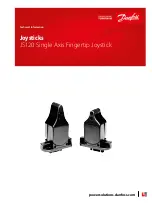
Documentation HG G-73650ZD | English, Revision 05 | Date: 09.03.2017 | www.goetting-agv.com
14
Chapter 2: Basic Principles of Track Guidance
The example shows two possible mounting positions of the antenna on the vehicle. The first
position is 100 mm in front of the fixed axle (turquoise), the second one is 1500 mm in front
of the fixed axle (magenta). In both cases the vehicle drives around a curve with a radius of
500 mm. The example clearly shows that the first position is much better than the second
one:
–
The antenna's effective reading range for the first position is still 224 mm, for the sec-
ond position the range is reduced to 78 mm.
–
The reading accuracy of the first position is considerably higher. In both cases the
vehicle uniformly turns 4
o
(it turns with the same speed). The transponder readings
are displayed symmetrically to the posipulse. In position 1 the transponder is read in a
distance of 3,19 mm from the desired position (center of the antenna), in position
two with a reading error of 52,04 mm.
–
As the transponder moves much faster through the reading area in position two due
to the bigger lever, the error rate, generated by the timing, will increase.
–
Major corrective movements may lead to completely missing the transponder in posi-
tion two.
If it is not possible to install the antenna close to the fixed axle, e.g. on a fork-lift, the follow-
ing should be observed:
–
It should not be attempted to read transponders in tight turns. It is better to place a
pair of transponders with a distance of at least 0.5 m before and after the curve.
–
Where curves are to be driven that are so long that transponders have to be read, the
radius has to be kept to the maximum possible and the speed should be as lowered
as much as possible.
–
The transponder antenna has to be mounted as close as possible to the rear axle
(fixed axle or fixed roller).
For omnidirectional vehicles make sure that the antenna is mounted as close as possible to
the center of the vehicle. Again the following applies:
The more tilted the vehicle moves the
more restricted the measurement is.
If the vehicle only drives in diagonal direction a calcu-
lation cannot be performed at all, since the transponders are no longer crossing the antenna
center and consequently no posi pulses are generated. For each transponder crossing only
one calculation is performed (posi pulse of the transponder).
2.3.2.1.2 Double Antenna Evaluation
Figure 7
Properties of a double antenna set-up
Vehicle X
Vehicle Y
Front
Antenna 1
Antenna 3
















































